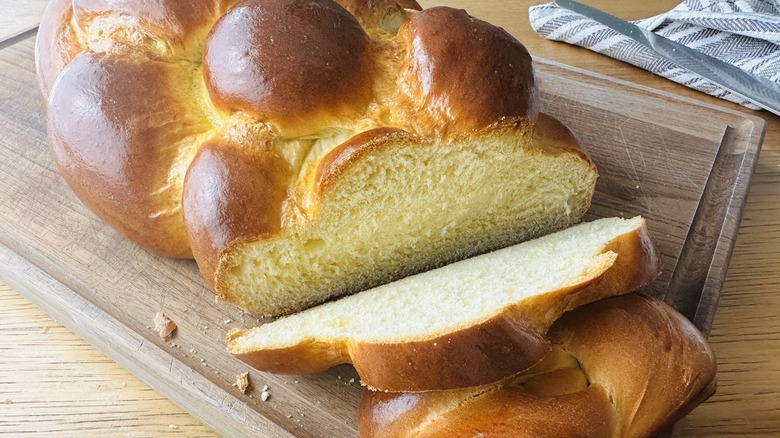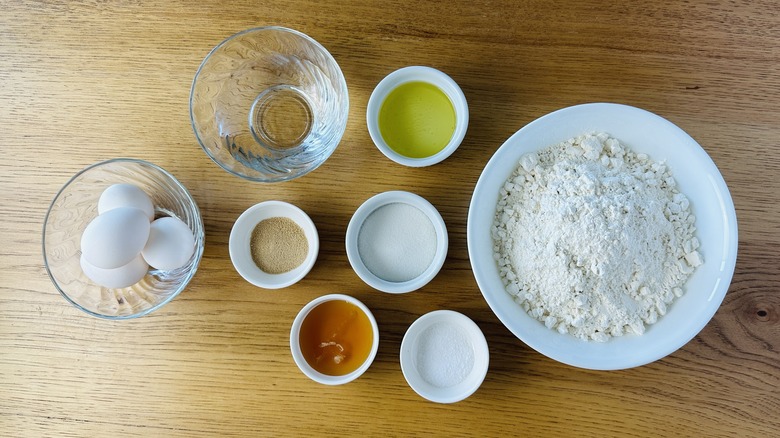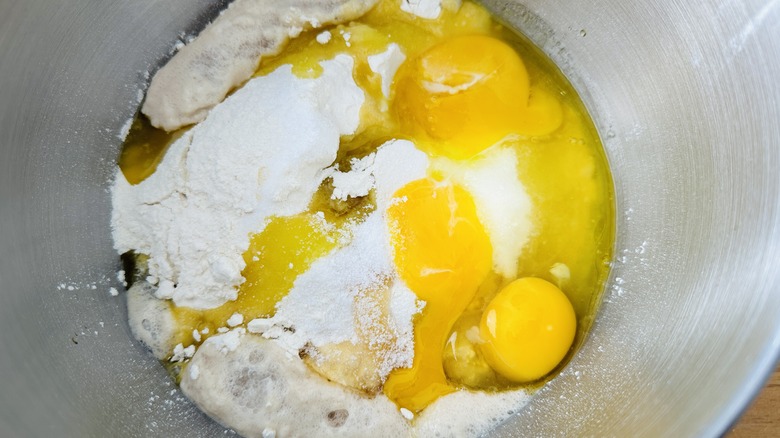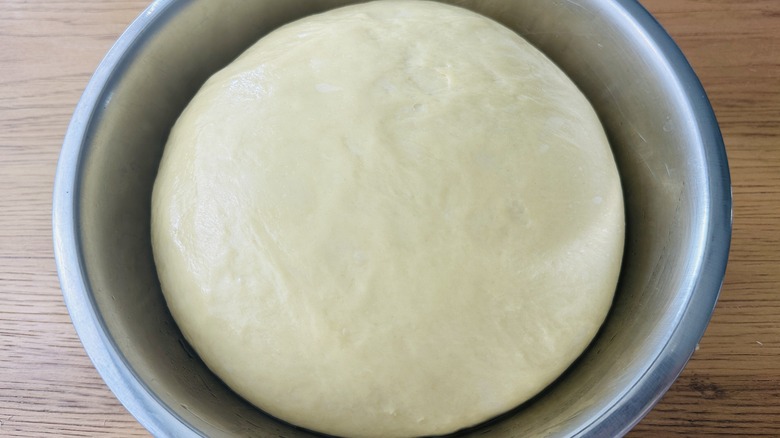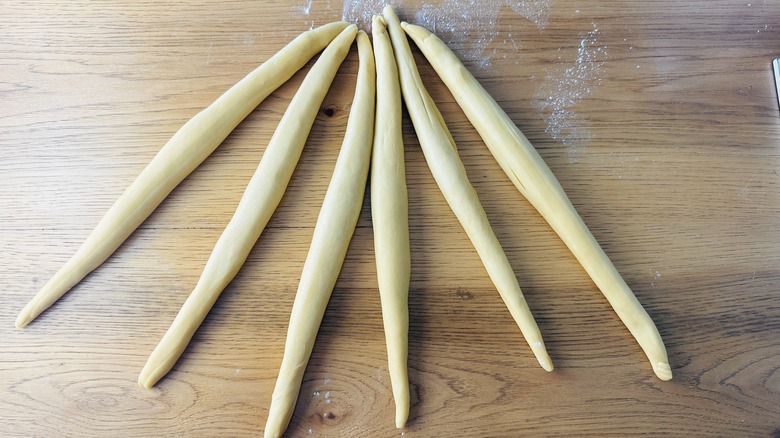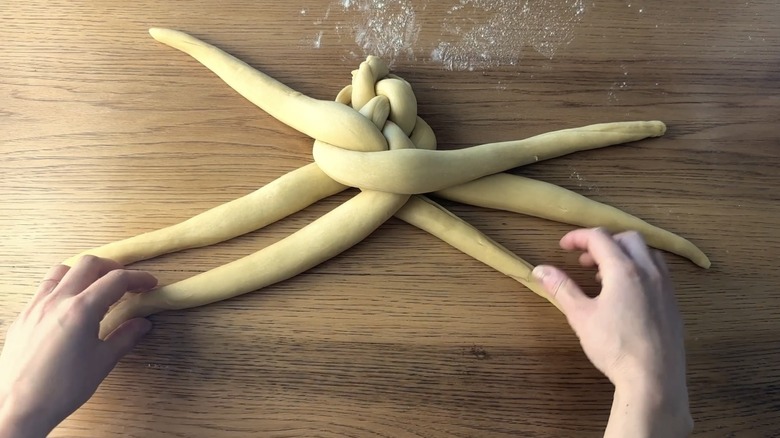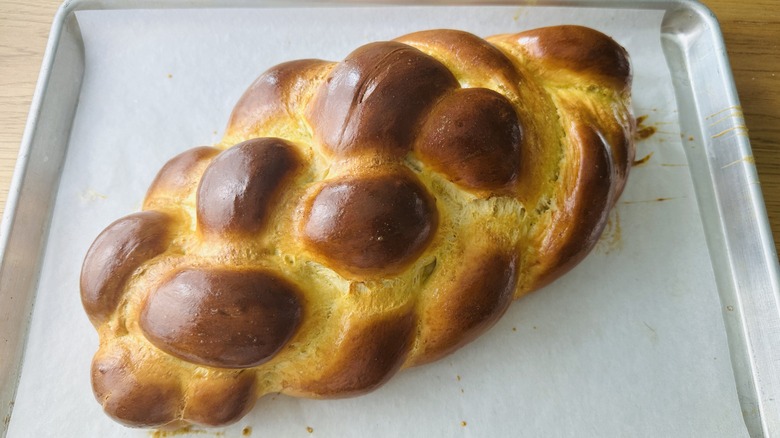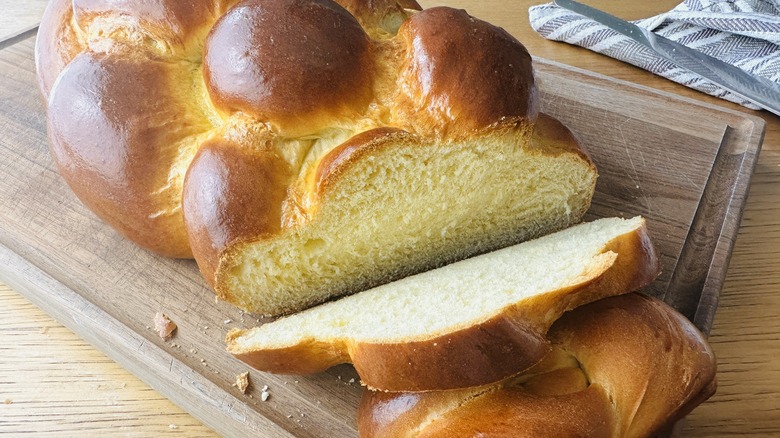Ultimate Challah Bread Recipe
Of all the varieties of bread out there, few are as visually striking as challah. While the braided bread is most often thought of as a mainstay of Shabbat dinners and a pillar in Jewish cuisine, challah can (and most definitely should be) enjoyed by anyone at any time. Aside from its unique shape and beautiful golden color, challah is delicious, with a subtly sweet taste and fluffy texture that's similar to brioche. You can eat a slice of challah with a simple slather of butter and jam, or get creative and use it as a base for French toast or sandwiches. It's a wonderfully versatile type of bread, and when made from scratch, it can't be beat.
Of course, many people tend to shy away from making bread at home. "Making challah from scratch can be intimidating," understands recipe developer Katie Rosenhouse. However, her favorite thing about this recipe is that "it's as straightforward as possible, while still achieving that amazing feathery texture and rich flavor of challah." Indeed, you will run into common bread challenges, like activating yeast and giving the dough plenty of time to rise, but as long as you follow the steps carefully, you'll be as golden as your freshly baked loaf of challah.
Gather the ingredients for the ultimate challah bread recipe
While the steps for this recipe are pretty involved, the ingredients list is nice and simple. You'll need active dry yeast, warm water, granulated sugar, honey, two whole eggs plus two yolks, canola or vegetable oil, bread flour, and kosher salt. Why the two sweet ingredients? "The balance of honey and granulated sugar gives the challah deep flavor," Rosenhouse says. "If you'd rather skip the honey, swap completely for sugar. But don't go all honey — it will make the dough a bit too sticky to work with."
These are the basic requirements, but if you want to get creative with your loaf down the line, Rosenhouse recommends sprinkling some sesame seeds, poppy seeds, or everything bagel seasoning on the loaf before it bakes. You can also mix other things into the dough, like raisins.
Make the dough
Like most bread recipes, this one starts with activating the yeast. To the bowl of a stand mixer, add the yeast, 1 teaspoon of sugar, and water, keeping in mind that the correct temperature for activating yeast is not too hot and not too cold, around 110 F. Stir to combine the ingredients, then cover the bowl for about 10 minutes. You'll know that the yeast is nice and active if your mixture is foamy after that time is up.
Next, add in the remaining sugar, honey, one egg, both egg yolks, oil, salt, and all but ¼ cup of the bread flour. Make sure your stand mixer is fitted with the dough hook attachment, then allow that to run on low speed for 8 to 10 minutes. By that point, you should have a cohesive dough that is smooth and pulling away from the sides of the bowl. As you'll soon find out, there will also be a hand-kneading portion of this recipe, but the stand mixer helps eliminate quite a bit of that elbow grease. "By kneading the dough first in the mixer and then by hand, you ensure good gluten development," Rosenhouse explains.
Knead the dough by hand, then let it rest
Turn the dough out onto a clean countertop and begin kneading it by hand for about 5 minutes. Keep in mind that you have that remaining ¼ cup of flour, so if the dough is too sticky, sprinkle the flour on as needed. "It takes a lot to overwork challah," Rosenhouse assures us. "If you're kneading completely by hand, you may have to increase your time by a few minutes. By the time you're done, the dough should be stretchy, smooth, and supple. If there's any doubt if you've reached the right point — knead on!"
Once your dough feels right, lightly oil a clean bowl and place the dough ball inside. Cover the bowl to let the dough rest on the countertop for 1 to 1 ½ hours, until it has doubled in size.
Roll the dough into thin strands
Now the crafty part of the recipe begins. Prepare a large baking sheet with parchment paper, then set it aside. Now, grab your rested, risen dough and divide it into six even sections. (Unless absolutely necessary, try to avoid using any extra flour during these next steps.)
Roll each section into a long, thin strand, about 14 to 16 inches in length, and make sure each end tapers off a bit, as "you want your challah to have that classic football shape," Rosenhouse explains. Line the strands up next to one another, then slide their top points together while keeping the bottom points in place. Your dough should look something like a six-legged octopus at this point, so if it does, you're on the track to a perfectly braided challah.
Braid the challah
With your six strands lined up and joined at the top, go ahead and cross the leftmost and rightmost strands over each other once. Then, take the top leftmost strand and move it to the center of the strands, then cross the second strand on the right to the leftmost spot. To continue braiding, you'll simply reverse the pattern, taking the rightmost strand and moving it to the middle, then taking the second strand on the left and crossing it over to the rightmost spot. Continue alternating between these steps until you've finished braiding, then pinch the bottom ends together and tuck them under the loaf.
If you feel overwhelmed or confused by this six-braid method, then fear not — Rosenhouse has some simpler solutions. "Braiding with three strands can be an excellent way to start when it comes to making challah! Braid in the traditional way you'd braid hair, and you've got an easy and gorgeous loaf," she explains. "For four strands, braid in the same way as you would six, pulling strands from the top and replacing with the second strand in on the opposing side, alternating sides and repeating until the braid is complete."
Rest the dough again, give it an egg wash, and bake
Once you're done braiding and tucking, cover the dough and let it rest once again, for 45 minutes to 1 hour. Half an hour into the resting, preheat your oven to 350 F. By the end of its rest, the dough should have puffed up some more and feel light and airy when poked.
Place the challah onto a parchment-lined baking sheet. Whisk together the remaining egg, a splash of water, and a pinch of salt, then rub the egg wash all over the dough — and we do mean all over: Be sure to get the sides and every crevice, as this will ensure that your challah has that beautiful brown color when baked.
Speaking of baking, go ahead and transfer the dough to the oven, allowing it to bake for an initial 20 minutes. Take the challah out to rub some more egg wash on any lighter areas of the loaf, then rotate the pan and return it to the oven for another 15 to 20 minutes. You'll know the bread is done when the whole loaf has taken on a deep golden brown color.
Slice and serve the ultimate challah
You'll now want to transfer the challah to a wire rack and allow it to cool completely. Once it does, you can slice it up and enjoy it right away. "Challah is wonderful for sandwiches, French toast, served with holiday meals, and so much more," Rosenhouse says. This bread is also delicious on its own, with its thick-yet-fluffy texture holding up well to any spread your heart may desire. It did take some time and effort, but now you've got a perfectly baked, beautifully braided, homemade loaf of challah bread that will disappear more quickly than you might anticipate.
Ultimate Challah Bread Recipe
Braiding challah isn't as hard as it might sound. Follow this step-by-step recipe, and you'll become familiar with the techniques behind this beloved bread.
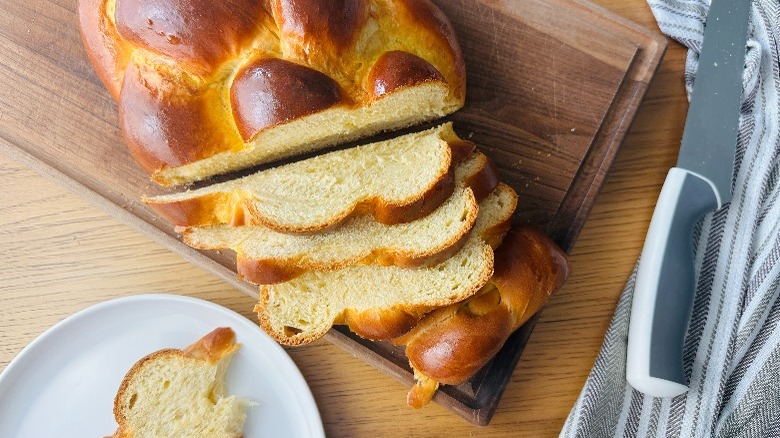
Ingredients
- 4 teaspoons active dry yeast
- ¾ cup warm water
- ¼ cup granulated sugar, divided
- 2 tablespoons honey
- 2 large eggs, divided
- 2 large egg yolks
- ⅓ cup canola or vegetable oil, plus additional for greasing bowl
- 4 ½ cups bread flour, divided
- 2 ½ teaspoons Kosher salt
Directions
- In the bowl of a stand mixer, stir the yeast, warm water, and 1 teaspoon of sugar to combine. Cover with plastic wrap or a towel and set aside for 10 minutes until foamy.
- To the same bowl, add remaining sugar, honey, 1 egg, both yolks, oil, 4 ¼ cups bread flour, and salt. Using a hook attachment, knead the dough on low speed for 8-10 minutes until smooth and pulling away from the sides of the bowl.
- Transfer dough to a clean countertop and knead by hand for an additional 5-6 minutes. If too sticky to work with, dust with remaining flour a tablespoon at a time until workable. Dough should be smooth and stretchy. Form into a ball.
- Lightly oil a medium bowl and place dough inside. Cover and set aside to rise for 1-1 ½ hours until doubled in volume.
- Line a baking sheet with parchment paper and set aside.
- Place the dough onto a clean countertop and divide into 6 sections. Resist dusting with flour unless necessary. Roll each section into a 14-16-inch rope that tapers on both ends.
- Lay the ropes side by side and pinch them all together at the top.
- Cross the top right and left strands once.
- To continue braiding, move the topmost left strand down to the center of the remaining strands. Move the second strand from the right to the top left position.
- Repeat, reversing the pattern: Move the topmost right strand down to the center of the remaining strands, and the second strand from the left to the top right position.
- Repeat, alternating the previous 2 steps until you reach the end of the braid.
- Pinch or roll ends of challah to seal, tucking any excess dough under the loaf.
- Cover and set aside to rise for 45-60 minutes until puffed in size and marshmallow-y in texture when poked. When poked, the dough should feel light and airy, and your finger should leave a slight indent behind. After 30 minutes, preheat oven to 350 F.
- Whisk remaining egg with a splash of water and pinch of salt. Gently brush over rested loaf, making sure to coat all areas and creases.
- Bake for 20 minutes. Remove the loaf from the oven and quickly brush with egg wash once more, focusing on any light areas. Return to oven, rotate, and bake an additional 15-20 minutes until deep golden brown.
- Transfer to a rack; cool completely before slicing.
Nutrition
| Calories per Serving | 293 |
| Total Fat | 8.7 g |
| Saturated Fat | 1.1 g |
| Trans Fat | 0.1 g |
| Cholesterol | 61.6 mg |
| Total Carbohydrates | 45.0 g |
| Dietary Fiber | 1.6 g |
| Total Sugars | 7.2 g |
| Sodium | 215.2 mg |
| Protein | 8.2 g |
